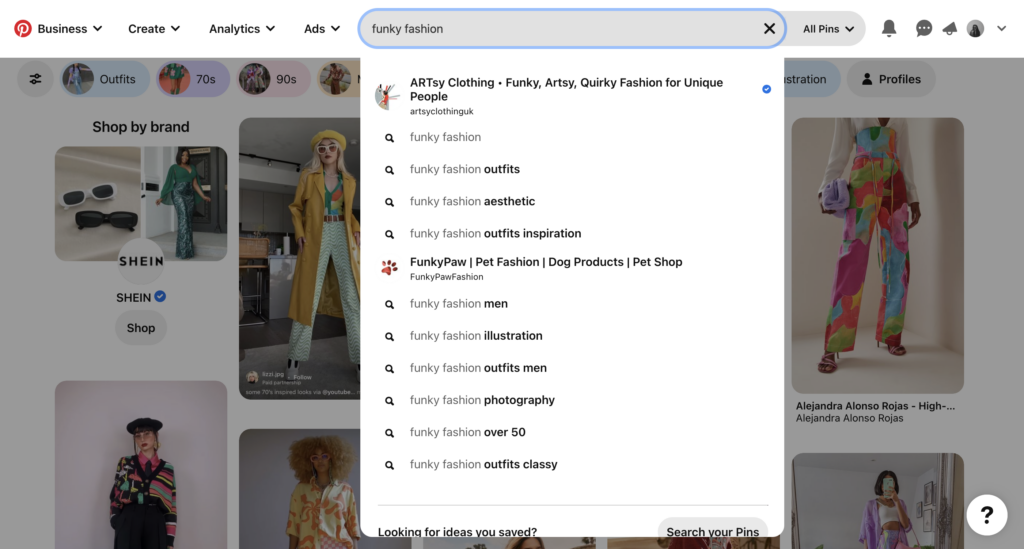
E-commerce Pinterest Strategies – 4 Essentials You Need
Hey, i'm Han.
Pinterest queen, funnels expert, and your soon-to-be biz bestie!
MORE ABOUT ME
WORK TOGETHER
Having an e-commerce Pinterest strategy is vital to successfully marketing on Pinterest… but what goes into building one? I’ll show you! Let’s first take a peek at why e-commerce brands should be prioritizing Pinterest in the first place.
Pinterest’s own target audience has shifted a bit over the years. What used to be a space dominated by bloggers and creators is now becoming an e-commerce bonanza. Not only are online shops and product-based businesses seeing the opportunity to skyrocket their sales, but Pinterest is actively advertising itself as the best place for e-commerce brands to do just that.
In 2023, I noticed a huge shift towards becoming more of a shopping platform. Pinterest was cold pitching accounts through email and offering personal assistance with ad campaigns. They were offering free ad credits, launching Pinterest Academy, and enhancing their business tools. The algorithm also changed, putting more emphasis on product pins, ads, and by adding the ability to search for similar products just by clicking on a pin.
Huge brands have taken notice, jumping onto the platform (often with little-to-no real strategy) to establish authority and grow their presence. And it’s worked out great for them so far! But I think it could work even better if these e-commerce brands applied just a bit more strategy to their efforts.
This is what I’d recommend to these e-commerce brands!
These are the 4 things I’d recommend to an e-commerce brand to improve its Pinterest strategy:
1. Improve your Pinterest keyword research
The keywords that work really well for Google might not be the ones that work well for Pinterest. So, I highly recommend utilizing the search bar, trends tool, and maybe even software like Pin Inspector 2 (link) to begin your research.
Pro tip: start with the keywords you’re already ranking for in Google, type them into the search bar, and see what comes up. Check out the search results:

Or the related search bubbles at the top of the search results (which aren’t always there):

Try throwing them into the trends tool to compare similar keywords too. Once you have your list of keywords, start adding them to your boards and pins (never keyword-stuffing or using hashtags – always using complete sentences and CTAs).
2. Learn how to become a Verified Merchant on Pinterest (a must for e-commerce brands)
It can be a tedious process, but it’s worth it. Not only will you get a fun little checkmark next to your name, but you’ll also be a preferred, trusted e-commerce shop, trusted by your audience AND by Pinterest (hello further reach!).
Here are just a few of the benefits:
- Your organic pins will be distributed within the shopping algorithm. This means you could show up in the shopping feed, when someone uses the visual search tool, and more.
- You’ll get that blue checkmark!
- You can display the price, availability, and more on your product pins.
- For some merchants, you’ll get access to merchant details, which are basically just extra words displayed on your profile to share your values and connect with your customers.
You can learn how to apply to the Verified Merchant Program and make sure your site and products fit within the merchant guidelines before you submit your catalog.
3. Building your e-commerce Pinterest funnel
We could go deep into the stages of awareness and how that affects your sales, but I already did that in this blog post. You just need to know that a good chunk of your audience is going to need to be nurtured before they ever buy from you.
They need to be convinced that you are the right brand to solve whatever problem they have, out of the sea of other shops selling the same thing you are. You also need to be top of mind whenever they are ready to make their purchase.
How do you do stay top of mind? Lemme tell show ya 😉
Sales funnels are vital to e-commerce brands. Companies that prioritize the nurture phase of their funnels generate 50% more sales-ready leads and nurtured leads make 45% larger purchases than non-nurtured leads. It’s pretty clear that investing in the nurture phase of your funnel is wildly profitable. So, how do you nurture potential customers?
For an e-commerce brand, email marketing is a no-brainer. But getting people on your email list is not as simple as throwing a “Subscribe!” box somewhere on your website. No, you gotta offer something in return, babe, and you do that with a lead magnet.
Lead magnets for e-comm brands could look like a discount code or free shipping. Or you could go the extra mile and create massive amounts of trust with some kind of quiz! But what happens once they’re on the list?
Well, I recommend you consult with an email marketing professional for an official strategy, but I can recommend sharing more about your brand, founding story, your values, and most importantly, offering a crap-ton of VALUE. Whether that’s an exclusive sale for subscribers only, sending discount codes, or maybe even solving some of their problems and addressing their potential objections.
Regardless, your email marketing strategy should be centered around serving your customers. The more free value you serve, the more trusted and valuable your brand becomes in your customers’ eyes. It also keeps you top of mind whenever they are ready to buy!
4. Product tagging your pins
This is a wildly underutilized feature in the e-commerce space on Pinterest. You can tag your products in other pins you post!
Let’s say you have a home decor shop and one of the pins you promote is a photo of an office that was designed with various products from your shop. You can tag up to 8 of those products on the pin itself, so when someone clicks on your pin, they can see exactly where to buy those pieces that caught their eye. You can learn exactly how to do that here!
Concluding notes
There are plenty of other things that go into a good Pinterest strategy like pinning frequency, profile optimization, and conversion analysis, which I share all about in my course, Power of Pinterest. But these are my general essentials and they’ll make a difference regardless of whether or not you buy my course! Put them into action, boo, you got this.
If you found this post helpful, it would mean the world to me if you’d share it with your people on Pinterest! Just hover over the image below, click the “pin it” button, and share!

